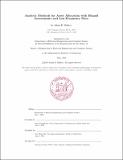| dc.contributor.advisor | Peter Kempthorne and Ray Ming Yeh. | en_US |
| dc.contributor.author | Slakter, Adam R | en_US |
| dc.contributor.other | Massachusetts Institute of Technology. Department of Electrical Engineering and Computer Science. | en_US |
| dc.date.accessioned | 2018-12-11T20:40:36Z | |
| dc.date.available | 2018-12-11T20:40:36Z | |
| dc.date.copyright | 2018 | en_US |
| dc.date.issued | 2018 | en_US |
| dc.identifier.uri | http://hdl.handle.net/1721.1/119571 | |
| dc.description | Thesis: M. Eng., Massachusetts Institute of Technology, Department of Electrical Engineering and Computer Science, 2018. | en_US |
| dc.description | This electronic version was submitted by the student author. The certified thesis is available in the Institute Archives and Special Collections. | en_US |
| dc.description | Cataloged from student-submitted PDF version of thesis. | en_US |
| dc.description | Includes bibliographical references (pages 89-90). | en_US |
| dc.description.abstract | Investing in illiquid assets poses a challenge to investors, as the low-frequency data makes it difficult to quantify the risks across portfolios and make asset allocation decisions. This work reviews several principal methods to infer missing data and tests their implications for asset allocation. It compares these methods by applying them to hypothetical portfolios in a realistic simulation environment, helping allocators decide which methodology to use and when. Proxy-based methods, which utilize a related series of higher-frequency observations, outperform non proxy-based inference techniques when the correlation of the available proxy is above 0.3. If data autocorrelation is high, models such as Kalman filters, which are capable of explicitly modeling the autocorrelation outperform other proxy-based methods. In normal market conditions, the CL Method gives the best overall performance of methods tested, indicated by low RMSEs and reliable forecasts for mean return, volatility, Sharpe Ratio, and drawdown. Keywords: Illiquid Investments, Low-Frequency Data, Missing Data. | en_US |
| dc.description.statementofresponsibility | by Adam R. Slakter. | en_US |
| dc.format.extent | 100 pages | en_US |
| dc.language.iso | eng | en_US |
| dc.publisher | Massachusetts Institute of Technology | en_US |
| dc.rights | MIT theses are protected by copyright. They may be viewed, downloaded, or printed from this source but further reproduction or distribution in any format is prohibited without written permission. | en_US |
| dc.rights.uri | http://dspace.mit.edu/handle/1721.1/7582 | en_US |
| dc.subject | Electrical Engineering and Computer Science. | en_US |
| dc.title | Analytic methods for asset allocation with illiquid investments and low-frequency data | en_US |
| dc.type | Thesis | en_US |
| dc.description.degree | M. Eng. | en_US |
| dc.contributor.department | Massachusetts Institute of Technology. Department of Electrical Engineering and Computer Science | |
| dc.identifier.oclc | 1076344627 | en_US |
